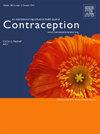生殖管理和不确定性在避孕决策中的作用
IF 2.3
2区 医学
Q1 OBSTETRICS & GYNECOLOGY
引用次数: 0
摘要
多布斯诉杰克逊妇女健康组织案的判决在全美范围内加剧了堕胎政策的不确定性,对已经面临生殖保健交叉结构性障碍的黑人妇女造成了不成比例的影响。本研究考察了俄亥俄州黑人妇女如何应对这种不确定性,探讨了在限制性和不断发展的生殖政策环境中影响她们避孕决策的个人、社会和制度因素。方法对来自俄亥俄州不同社会经济和地理背景的27名育龄黑人妇女进行深度访谈。采用现象学定性方法,我们采用半结构化访谈来检查参与者的避孕决策过程。在Braun和Clarke的六步框架的指导下,主题分析被用来识别重复的模式和主题。我们综合了这些叙述的发现,以捕捉政策不确定性下生育决策的复杂性。结果虽然一些参与者改变了避孕措施的使用,以减轻对其生殖自主的威胁,但政治话语对避孕行为的总体影响有限。决策主要是由个人、社会和健康相关因素驱动的,而不是政治叙事。结论:该研究强调,面对政策驱动的流产获取不确定性,避孕决策的微妙和审慎性质。俄亥俄州黑人妇女的避孕决策受到个人、关系和系统因素的交叉影响,反映了在限制性政策环境中引导生殖自主的复杂性。处理每一个这些因素对于确保在后多布斯时代作出知情和自主的生殖健康决策至关重要。本文章由计算机程序翻译,如有差异,请以英文原文为准。
REPRODUCTIVE GOVERNANCE AND THE ROLE OF UNCERTAINTY IN CONTRACEPTIVE DECISION MAKING
Objectives
The Dobbs v. Jackson Women’s Health Organization decision introduced heightened abortion policy uncertainty across the US, disproportionately impacting Black women already navigating intersecting structural barriers to reproductive care. This study examined how Black women in Ohio respond to this uncertainty by exploring the personal, social, and institutional factors influencing their contraceptive decision making in a restrictive and evolving reproductive policy landscape.
Methods
In-depth interviews were conducted with 27 Black women of reproductive age from diverse socioeconomic and geographic backgrounds across Ohio. Using a phenomenological qualitative approach, we employed semi-structured interviews to examine participants’ contraceptive decision making processes. Thematic analysis, guided by Braun and Clarke’s six-step framework, was used to identify recurring patterns and themes. We synthesized findings from these narratives to capture the complexities of reproductive decision making amid policy uncertainty.
Results
While some participants modified their contraceptive use to mitigate perceived threats to their reproductive autonomy, political discourse had a limited impact on contraceptive behaviors overall. Decision making was primarily driven by personal, social, and health-related factors, rather than political narratives.
Conclusions
The research underscores the nuanced and deliberative nature of contraceptive decision making in the face of policy-driven uncertainty around abortion access. Contraceptive decision making among Black women in Ohio is shaped by intersecting personal, relational, and systemic factors, reflecting the complexity of navigating reproductive autonomy in a restrictive policy environment. Addressing each of these factors is essential to ensuring informed, autonomous reproductive health decision making in the post-Dobbs era.
求助全文
通过发布文献求助,成功后即可免费获取论文全文。
去求助
来源期刊

Contraception
医学-妇产科学
CiteScore
4.70
自引率
17.20%
发文量
211
审稿时长
69 days
期刊介绍:
Contraception has an open access mirror journal Contraception: X, sharing the same aims and scope, editorial team, submission system and rigorous peer review.
The journal Contraception wishes to advance reproductive health through the rapid publication of the best and most interesting new scholarship regarding contraception and related fields such as abortion. The journal welcomes manuscripts from investigators working in the laboratory, clinical and social sciences, as well as public health and health professions education.
 求助内容:
求助内容: 应助结果提醒方式:
应助结果提醒方式:


